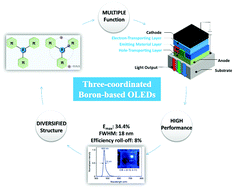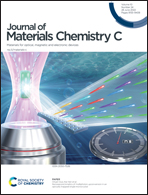High-performance three-coordinated organoboron emitters for organic light-emitting diodes
Abstract
The bright luminescence, easy synthesis, and high thermal and chemical stability of three-coordinated organoboron have made it a promising candidate for organic light-emitting diode (OLED) applications. The application of three-coordinated organoboron in OLED devices can be traced back to the 1990s. To improve the molecular stability and emission properties of these devices, various three-coordinated organoboron compounds have been designed, including dimesitylboryl derivatives, dibenzoboroles, 9,10-diboraanthrancene derivatives, structure-constrained triarylboranes, and azaboranes. Three-coordinated organoboron represents one of the most attractive OLED materials: devices using three-coordinated organoboron compounds in the emitting layer have shown outstanding performance characteristics such as a high external quantum efficiency (EQE), low EQE roll-off, narrow emission bandwidth, and full-colour emission. This review is intended to comprehensively address the important progress in boron-containing materials for OLED applications, with an emphasis on the structural design. The new structures of three-coordinated organoboron compounds developed for OLED applications, including traditional fluorescent materials, phosphorescent materials, and state-of-the-art thermal-activated delayed fluorescence (TADF) materials, are summarized comprehensively.



 Please wait while we load your content...
Please wait while we load your content...